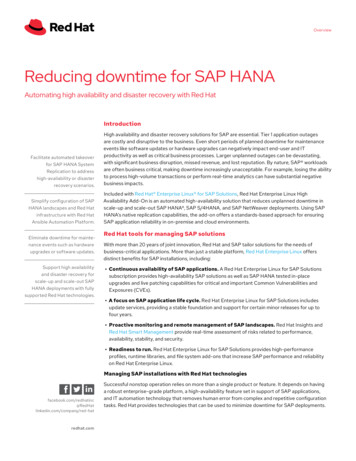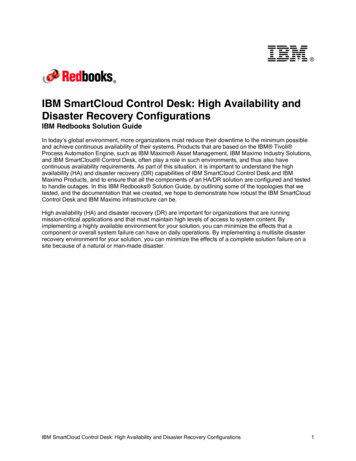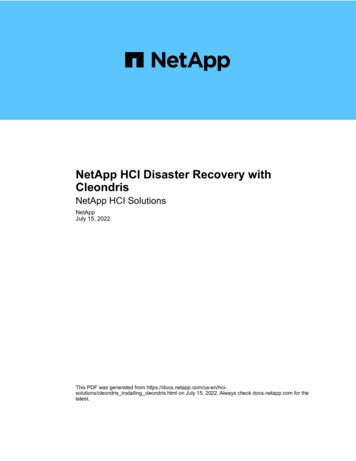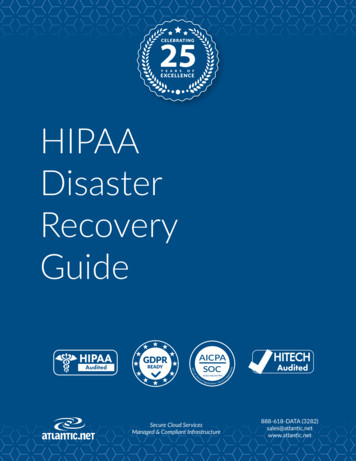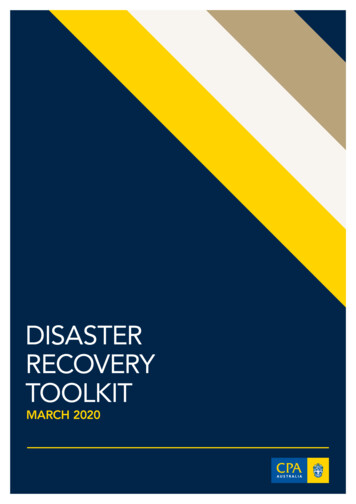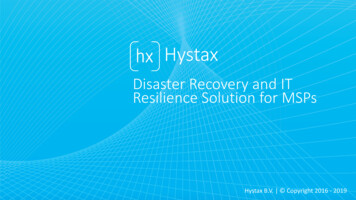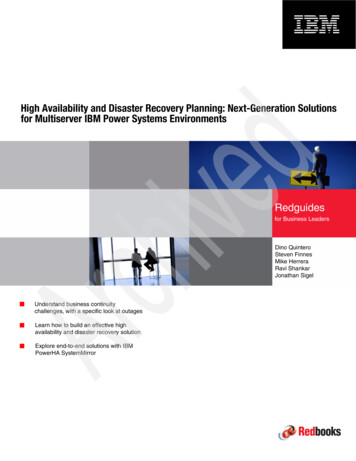
Transcription
Front coverHigh Availability and Disaster Recovery Planning: Next-Generation Solutionsfor Multiserver IBM Power Systems EnvironmentsRedguidesfor Business LeadersDino QuinteroSteven FinnesMike HerreraRavi ShankarJonathan SigelUnderstand business continuitychallenges, with a specific look at outagesLearn how to build an effective highavailability and disaster recovery solutionExplore end-to-end solutions with IBMPowerHA SystemMirror
OverviewIn a volatile and technology-dependent business climate, downtime, whether it is planned orunplanned, is costly. According to a recent IDC report,1 the cost of IT downtime toorganizations can range from thousands to millions of dollars per hour. A 2009 studypublished by the Information Availability Institute effectively makes the point that measurableobjectives should be made based on “the needs of the business, not the capabilities ofcurrent technologies and procedures.”2 High availability and data protection are not newconcepts to IT professionals. What is new are the expanding options and capabilities arounddeployment of highly available environments that offer varying levels of data, application andinfrastructure resilience.Many tiers of a high availability disaster recovery (HADR) solution are possible. The rightHADR configuration is a balance between recovery time requirements and cost. Criticaldecisions must be made to determine which services within the business must remain onlinein order to continue operations.IBM Power Systems customers who use AIX (UNIX ) and IBM i operating systemsalready benefit from the industry-leading resiliency capabilities (reliability, availability, andserviceability (RAS)) of the platform. These customers can further benefit from thecontinuous availability offered by the IBM PowerHA SystemMirror solution. Power Systemsservers have become the platform of choice for clients who are running their business-criticalworkloads. Vital transactions, such as bank deposits, medical claims, logistics of criticalgoods shipments and benefit payments, are processed every day in IBM AIX and IBM ienvironments all over the world.In this IBM Redguide publication, we define the fundamental concepts for high availability,present considerations for building a strategy, and make suggestions for choosing an effectivehigh availability and disaster recovery strategy depending on your environment. We offerdetails about how IBM PowerHA SystemMirror tightly integrates with the Power Systemsservers, IBM operating systems, and storage to help meet business continuity requirements.We also discuss the challenges posed by a myriad of environmental risks, changing businessenvironments, and compliance issues.12Source: IDC report “Leveraging Clustered File Systems to Achieve Superior Application Availability,” document219198, published July 2009; available at (IDC login required):http://www.idc.com/getdoc.jsp?sessionId &containerId 219198&sessionId 530BF8F472193221DE4563C85617FD4FSource: Information Availability Institute study “The State of Resilience on IBM Power Systems ,” published in2009. Copyright IBM Corp. 2010. All rights reserved.1
This document is a reference guide, with a definitive collection of approaches, that outlineshigh availability offerings from IBM and includes characteristics and respective requirements.The intended audience for this paper is both customers and consultants who are looking for anoverview of high availability solution approaches specifically for Power Systems environments.This guide includes the following topics: “The need for high availability and disaster recovery solutions” on page 2“Establishing common requirements” on page 3“End-to-end solution components” on page 5“Application data resiliency: Methods and characteristics” on page 5“Solution options for Power Systems clients” on page 10“Summary” on page 11What is high availability?High availability is a generic term used by the IT industry to describe the accessibility anduptime of critical IT application environments. From a technology perspective, high availabilitysolutions always involve redundancy. For example, RAID 5 enables highly available diskarrays through a form of data redundancy.No one can expect to achieve the popularly coined “five nines of availability” (shown inTable 1) by using technology alone. A highly available environment is a combination oftechnology, change control, skills and overall IT operational discipline.Table 1 The five nines of availabilityUptimeUptimeMaximum downtime per yearFive nines99.999%5 minutes 35 secondsFour nines99.99%52 minutes 33 secondsThree nines99.9%8 hours 46 minutesTwo nines99.0%87 hours 36 minutesOne nine90.0%36 days 12 hoursThe need for high availability and disaster recovery solutionsHigh availability is a key component of business resiliency. It is widely documented thatoutages increase the total cost of IT ownership and cause potential damage to clientrelationships and loss of revenue. Although hardware has become highly reliable, researchshows that unplanned outages occur and typically result from operator error, software bugs,environmental conditions and other non-hardware related factors—problems that reliablehardware cannot prevent. Planned outages for application and system maintenance alsoimpact business performance. Businesses are aggressively shrinking the time allotted forthese types of activity.Disaster recovery solutions are an extension of high availability solutions with the addedcapability of providing resiliency with geographic dispersion. More IT shops are moving awayfrom outsourced disaster recovery operations to insourced disaster recovery operationsbased on continuous data replication between geographically dispersed locations. Moderndisaster recovery solutions require both geographic dispersion and recovery point objectives2High Availability and Disaster Recovery Planning
as close to zero as possible. Increasingly, IT shops are being asked to prove periodically thatthey can recover operations at a remote facility. The simple fact is that owning your owndisaster recovery solution is both economically sensible and gives you greater control overyour environment.Business Continuity Resiliency Services: IBM can also provide remote facilitiesworldwide through Business Continuity Resiliency Services (BCRS). You can learn moreabout BCRS at the following Web blishing common requirementsThe following requirements are the most common IT considerations for establishing anHADR solution:Recovery time objective (RTO)The time as measured from the time of application unavailability to thetime of recovery (resuming business operations).Recovery point objective (RPO)The last data point to which production is recovered upon a failure.Ideally, customers want the RPO to be zero lost data. Practicallyspeaking, we tend to accept a recovery point associated with aparticular application state.Planned downtime In normal day-to-day operations, the largest share of time that anapplication is rendered unavailable because of planned maintenanceprocedures, such as system saves or operating system upgrades andthe like. In an ideal environment, a redundant resource is used to carrythe production workload so that the primary environment can undergomaintenance. The faster that you can switch between the primary andsecondary nodes in a cluster, the less impact there is to the productionenvironment.Geographic dispersionIn the context of a multisystem HADR solution topology, the capability torecover operations at a remote location. This requirement is increasinglydriven by compliance regulations, dispersion of the data, and thegrowing importance to have a complete disaster recovery solution.Ease of managementThe degree of automation that an HADR solution offers to an IToperations staff. Consider both the degree of skill specializationrequired to manage the solution and its practical capability whenapplied to various resiliency operations such as planned failover or roleswap operations.Ease of deployment Clients ultimately want an HADR solution that is simple to configure.Through the use of node discovery functions, Smart Assists andconfiguration wizards for AIX deployments, and independent auxiliarystorage pools (IASPs) for IBM i environments, IBM clustering solutionscan reduce the amount of time required to deploy an environment.3
Integration and supportWhen up and running in production, the degree of integration with theoperating system influences the robustness of the solution, the types ofskills required to manage the solution, and the types of support thatmight be involved in the event of a problem.Outage types to considerThis guide focuses specifically on high availability solutions that involve multiple independentsystems referred to as nodes, which are incorporated into a cluster. To achieve highavailability, the solution must be designed with consideration of all aspects of the environmentwith the infrastructure being a critical building block.A high availability solution should address the following types of outages: Scheduled outagesOutages in the hardware subsystems (central processor complex (CPC), I/O, disk)Outages in the application, operating system, or bothOperator error outagesFor any high availability solution approach, evaluate it in the context of the previously mentionedoutage types. Considerations include whether the solution covers each of these outages orsome of these outages, and whether the coverage is adequate for the stated IT resiliencyobjectives and requirements. Customers must identify the outage types that require coverageand evaluate the solution options to determine which option best fits their requirements.Generally speaking, disaster recovery solutions provide protection against natural disasters(earthquake, floods, or fire, which can lead to extended site power outages). Increasingly,corporate and governmental regulations are driving focus in this area. As you evaluate yoursolution options, consider whether a given solution can be effectively deployed in ageographically dispersed topology to meet your corporate compliance objectives.Customer infrastructure can fail because of various outage causes such as those that wepreviously mentioned. Hardware failures represent only a small percentage of the totalfailures. Nearly 50% of outages are the result of software and operator errors. These are allinstances in which a high availability solution can help shorten outage windows and canprovide a reliable mechanism to move critical resources between highly available servers. Ina multisite disaster recovery implementation, a clustered solution can further extend its reachand manage the replication of the data between the sites. Such a solution can automaticallyreverse the roles in the event of a local site failure.Table 2 outlines the groups of outage types to consider when evaluating a high availabilitysolution.Table 2 Outages to consider4GroupPossible outage types that an HADR solution might coverGroup 1CPC (hardware: CPU and memory)Group 2Network or storage adapter failures, cable disconnects and so onExternal errors: storage errors, switch errors and so onGroup 3Critical operating system resource: volume, file system, IP and so onGroup 4Application, middleware, and operator actionsHigh Availability and Disaster Recovery Planning
GroupPossible outage types that an HADR solution might coverGroup 5Site outagesThe IBM PowerHA SystemMirror Enterprise Edition solution reliably orchestrates theacquisition and release of cluster resources locally or from one site to another in the event ofan outage or natural disaster. The solution incorporates end-to-end components as describedin the following sections.End-to-end solution componentsA comprehensive HADR solution has the following basic components: Application data resiliencyApplications require access to data or copies of the data to perform business-criticaloperations. Therefore, data resiliency is the base or foundational element for a highavailability and disaster recovery solution deployment. Application infrastructure resiliencyInfrastructure resiliency provides the overall environment that is required to resume fullproduction at a standby node. This environment includes the entire list of resources thatthe application requires upon failover for the operations to resume automatically. Application state resiliencyApplication state resiliency is characterized by the application recovery point as describedwhen the production environment resumes on a secondary node in the cluster. Ideally theapplication resumes on an alternate node at the last state where the application was onthe primary system when a failure occurred. Practically speaking, the characteristic of theapplication to resume varies by application design and customer requirements.A complete end-to-end solution incorporates all three elements into one integratedenvironment that addresses one or all of the outage types as described previously in thispaper. The behavior of a solution to a customer depends upon the inclusion and incorporationof these basic elements into the clustering configuration. For example, you can have asolution based purely upon data resiliency and leave the application resiliency aspects of thefinal recovery process to IT operational procedures. Alternatively you can incorporate thedata resiliency into the overall clustering topology enabling automated recovery processing.Application data resiliency: Methods and characteristicsBasic technologies are employed by HADR solution implementations to provide applicationdata resiliency. Each one has its particular characteristics and applications. Generallyspeaking, there are two distinct groups: storage-based resiliency and log-based replication.Storage-based resiliencyData resiliency across multiple nodes in a cluster is the foundation for building an effectivehigh availability solution. Storage replication is the most commonly used technique fordeploying cluster-wide data resiliency. There are two general categories for storage-basedresiliency: shared-disk topology and shared-everything topology.5
In this context, the following critical storage-related high availability criteria can be considered: Active storage sharing across the cluster (concurrent access) Shared-disk configuration (active-passive) Multisite replicated storageLocal clustering versus multisite replication: Active storage sharing across the clusterand shared disk configuration are both specific to local clustering. Storage replication canprovide multisite replication for the environment.Active storage sharing across the cluster (concurrent access)Often referred to as shared-everything storage, active storage sharing across the cluster is anactive-active ownership arrangement. In this arrangement, nodes in the cluster havesimultaneous read/write access to the shared data. The cluster management technologyperforms locking operations to ensure that only one node can perform an update or writeoperation at a time.The benefit of this approach is that no switching operation is associated with storageresiliency because the nodes simultaneously own the shared resource. If a node outageoccurs, another node in the cluster resumes production through a reassignment process. Thetechnology used to resume the application can be based on either journals or memoryreplication. Another consideration is the degree to which the entire application infrastructureis monitored and recovered. However, this type of sharing requires the individual softwaresubsystem to be aware of concurrent disk access to avoid data corruption.Shared-disk configuration (active-passive)Shared-disk configuration is an active-passive shared ownership arrangement betweennodes in the cluster. One node in the cluster performs read/write operations to the disks.Ownership of those resources can be passed to other nodes in the cluster as part of a failover(or rollover) operation. The operating system, application and data are all switched betweennodes. The recovery point is established by applying the journals that are in the shared diskresources. The recovery time is associated with the time it takes to apply the journal.Live Partition Mobility and shared-disk technologyVirtualizing physical resources is becoming prevalent on Power Systems servers. Virtualizedstorage area network (SAN)-attached volumes can be combined with POWER6 andPOWER7 hardware for clients to use extended features. For example, with Live PartitionMobility, logical partitions (LPARs) can be dynamically moved between servers with minimalimpact to the application. Live Partition Mobility functions, in combination with PowerHASystemMirror cluster solutions, can compliment the environment by providing non-disruptiveplanned maintenance while protecting against unexpected outages.HyperSwap configurationsShared-disk configurations can be extended by using a HyperSwap configuration where thedisks in a shared storage pool are mirrored between separate storage servers enablingresiliency between two storage servers. Continuous availability of the solution is assured evenif one of the storage servers fails.With this type of configuration, high availability is realized against server-based errors, andcontinuous availability is realized against storage errors. The nodes in the cluster haveaccess to the mirrored data across two separate storage servers, giving protection againstboth a primary server outage and a storage server outage.6High Availability and Disaster Recovery Planning
Multisite replicated storageThe shared-disk topology can further be extended for geographic dispersion by using eitherhost-based or storage server-based replication technology. Data in a storage pool isreplicated in a synchronous manner for zero loss implementations and in an asynchronousmanner for geographically dispersed sites where latency might impact operations.Host-based replicationHost-based replication implies that the host mirroring technology is doing the work. Hosts onthe two sides coordinate and replicate the data across the cluster. The major advantage ofhost-based replication is that it can work for any storage, irrespective of whether it supportsmirroring.Storage server-based replicationStorage server-based replication means that the storage server is performing the datareplication on behalf of the primary node. Perhaps more importantly, this type of replicationcan provide continuous data replication in the event of a production node outage and providesa common replication mechanism across various platforms.Synchronous replicationSynchronous replication means that the application state is directly tied to the completion ofthe write operation to both the local node and remote node. Synchronous replication providesa mechanism to ensure that no data (which is written to disk) is lost in relationship to theapplication in the event of an unplanned outage. It also means that the distance between theprimary and secondary nodes have a direct impact on the application response time.Asynchronous replicationAsynchronous replication means that the operations are synchronous and the storagesubsystem manages the synchronization between the primary and the secondary nodes.This technology enables the application to continue operations without waiting for the remotestorage operation to complete minimizing a performance impact. Data is typically replicated ingroups of volumes, and consistency is established within group boundaries. In the event of anunplanned outage, the recovery point on the remote server will be based on the lastconsistency boundary that is replicated to the remote storage subsystem.Log-based replicationLog-based replication is a form of resiliency primarily associated with databases. Typically,database logs are used to monitor changes that are then replicated to a second systemwhere those changes are applied. IBM i solutions that are based on this technology arereferred to as logical replication.Application infrastructure resiliencyApplication infrastructure resiliency has two aspects. First, it provides the application with allthe resources that it requires to resume operations at an alternate node in the cluster.Second, it provides for cluster integrity by using monitoring and verification.For an automated or semi-automated failover operation to work, all of the resources that theapplication requires to function on the primary node must also be present on the secondarynode. These resources include items such as dependent hardware, middleware, IPconnectivity, configuration files, attached devices (printers), security profiles, applicationspecific custom resources (crypto card) and the application data itself. These redundant7
resources are typically referred to as cluster resources and are managed by forming clusterresource groups. Dependencies established between the application and these resourcegroups form the key control mechanism, which ensures that the resources are prepared andavailable before the application resumes operations on the standby node.During day-to-day operations, the cluster monitors the resilient infrastructure resources forchanges that indicate a failure, a pending failure or a possible configuration change that mightcause a cluster operation (such as a failover) or an operator to take corrective action.Monitoring is primarily about the resources that must be tracked by the high availabilitysolution and the internal solution notifications that can trigger an action as defined by thepolicy for high availability management. An aspect of monitoring is performing periodicverification checks where specific or custom scans of the cluster resources are conducted toassess status against the intended configuration.These operations are performed in addition to real-time monitoring as an integrity check thatsupersedes the real-time monitoring function. A modern high availability solutionautomatically identifies changes and addresses them through auto-corrective features ornotifications methods. In addition to the monitoring and verification capabilities of a modernresilient infrastructure solution, cluster-wide management functions should be available thatenable the operator to perform various operations on behalf of the application and operatingsystem to maintain or update the resilient infrastructure.For example, if there is a need to expand the storage capabilities of the cluster, then anoperator should be able to add disks and include them as a cluster-wide resource by usingthe high availability-solution-provided central interface. The modern resilient clusteringinfrastructure should be able to monitor and manage the critical resources from a centralpoint of control versus performing these cluster-wide operations on each node individually.In regard to effective health monitoring and cluster-wide system management, the highavailability solution must be closely integrated with the host operating system. This integrationprovides for synergetic health management, application management, and system statemanagement.Cluster-aware operating systemsHealth management, if done externally to the operating system, can be prone to errors andscheduling issues. It can also cause ongoing management challenges. The healthmanagement process must be done from within the operating system or operating systemkernel to make it highly reliable and less reliant on user monitoring and intervention.A cluster-aware operating system naturally leads to the exploitation of the hardwareresources within the infrastructure (network adapters, SAN connections and so on) withminimal inputs from the user while providing for multiple redundant communication linksbetween the nodes in the cluster. This discovery-based configuration capability reduces themonitoring and configuration burden on the user who is responsible for maintaining the healthmanagement infrastructure.Enabling cluster awareness in the operating system enables operating-system-basedoperations to be in harmony with the cluster-wide high availability solution. In particular, itensures that operating-system-based operations do not accidentally disturb the cluster. Ahigh availability solution implemented with a cluster-aware operating system, exploits theoperating system features, extending them across the entire cluster, and enables centralizedcluster management of the infrastructure.8High Availability and Disaster Recovery Planning
The IBM PowerHA SystemMirror strategy is rooted in deep integration with the operatingsystem. IBM’s intention and strategy in an upcoming release of the PowerHA solution is toprovide a deeper integrated cluster aware operating-system-based high availability solution.For the next generation of the PowerHA SystemMirror solution on AIX, IBM aims to exploitAIX cluster-aware operating system capabilities, thus providing a more robust high availabilitysolution. The IBM i operating system is cluster aware and is exploited by PowerHA for IBM i6.1 and PowerHA SystemMirror for i 7.1.Application-state resiliencyAssume for a moment that you have deployed a clustering infrastructure. You haveimplemented your data resiliency based on a shared configuration, and your applicationinfrastructure resiliency is in place so that all of your application resources are available on asecondary node. You can failover (or roll over) to the alternate node in your cluster at will.The question you need to ask yourself is: Where will the application recovery point be withrespect to the last application transaction? If your application is designed with commitboundaries and the outage is an unplanned failover, then the recovery point in the applicationwill be to that last commit boundary. If you are conducting a planned outage role swap, thenthe application is quiesced so that memory can be flushed to the shared-disk resource andthe data and application are subsequently varied on to the secondary node.Many factors related to the environment will drive design decisions that will help achieve a setof resiliency objectives. While RPO, RTO and network recovery objective (NRO) play a criticalrole in establishing objectives, middleware and the application recovery characteristics willalso play an important role. For example, the database might take much longer time to do therecovery processing for 1 TB of data as compared to 100 GB of data.While application state resiliency depends on many characteristics of the environment, a highavailability solution should aid in health monitoring of the application stack. This solutionshould also provide for corrective actions in the cluster to reduce failover times and toaccelerate recovery times. For example, some middleware in a high availability configurationmight create a cache of application state information on another node in the cluster apartfrom the active node, thus enabling a quicker failover.Application friendly cluster infrastructureThe IBM PowerHA SystemMirror for AIX solution provides high availability managementagents called Smart Assists for key middleware management and application deployment.Smart Assists help customers define high availability policies that can be rapidly integrated forcritical workloads. They help in discovering the complex software that is deployed in thecluster. This discovery-based information is presented to the customer and aids in definingthe high availability policy for the site. After the high availability policy is set, the Smart Assistsprovide health monitoring methods and periodically checks the health of the middleware.Upon failure detection, middleware and its resource dependencies are restarted on the nodespecified by the policy. Smart Assists thus provide for end-to-end high availabilitymanagement of the middleware and application stack.PowerHA SystemMirror for IBM i clustering technology is an extension of the IBM i operatingsystem. The IBM i operating system is cluster aware, and PowerHA SystemMirror exploits theintegrated clustering technology, thus enabling a complete end-to-end solution for HADR. Theapplication friendly cluster infrastructure is primarily centered on exploiting the IASP data9
structure. A commercial application that has been set up for IASPs is readily deployed into aPowerHA SystemMirror HADR cluster. Deploying an IASP data structure is generallystraightforward. Many IBM i customers with home-grown applications have implementedPowerHA for IBM i 6.1. Several of the major IBM commercial application providers havealready implemented PowerHA support, and many more are coming on line.Solution options for Power Systems clientsIn combination with leading RAS features of IBM Power Systems servers, IBM PowerHAclustering software effectively helps detect any component failure and reacts accordingly,shortening the amount of time to recovery or masking a failure altogether.The IBM PowerHA SystemMirror Enterprise Edition solution for Power Systems can provide avaluable proposition for reliably orchestrating the acquisition and release of cluster resourceslocally or from one site to another in the event of an outage or natural disaster.Now that we have reviewed the dimensions involved in the establishment of an optimalsolution for your HADR operations, you can see the options that are available to PowerSystems clients in Table 3 and Table 4 on page 11. The event groups are defined in Table 2on page 4.Table 3 High availability solutions offerings for Power Systems ationPowerHASystemMirrorfor AIXGroups 1, 2, 3,4 and 5Shared-disk,replication,localHyperSwap GeographicalLogical VolumeManager (GLVM)Metro MirrorGlobal MirrorEMC SymmetrixRemote DataFacility ter-wide monitoringfor groups 1, 2, 3, 4and 5AIX clusterawareVMControl,Live PartitionMobility
from outsourced disaster recovery operations to insourced disaster recovery operations based on continuous data replication between geographically dispersed locations. Modern disaster recovery solutions require both geogra phic dispersion and recovery point objectives Uptime Uptime Maximum downtime per year Five nines 99.999% 5 minutes 35 seconds

